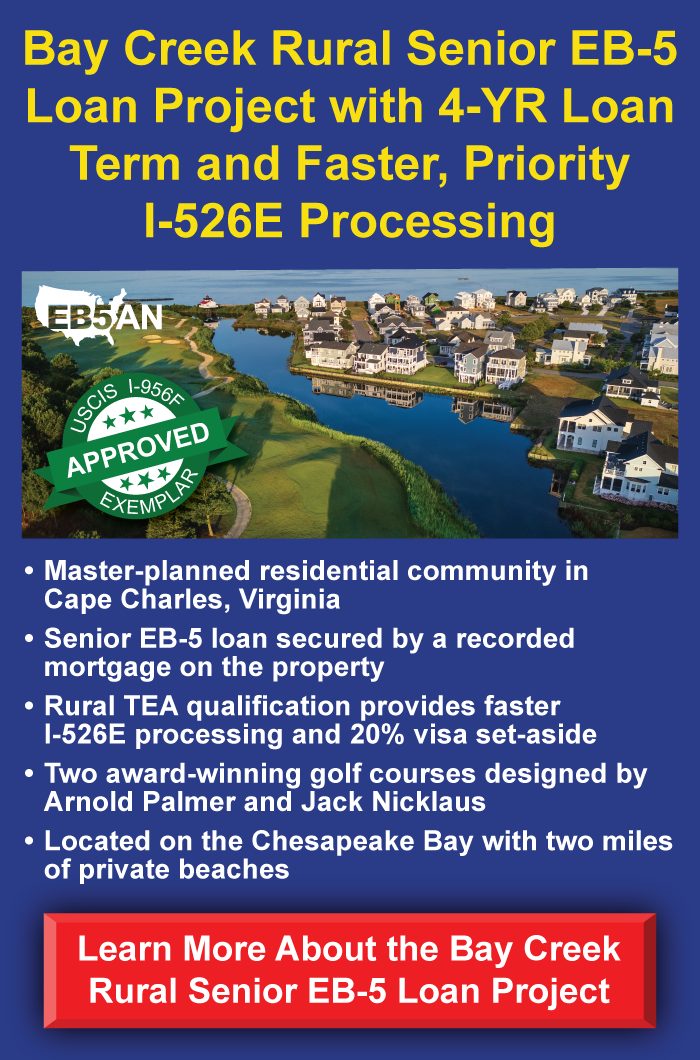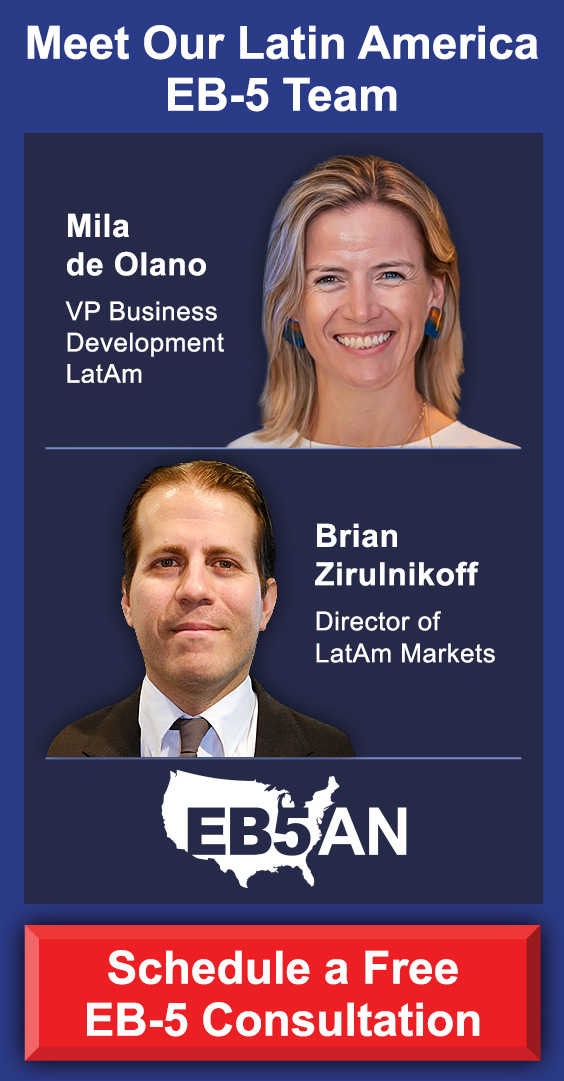The EB-5 Reform and Integrity Act of 2022 (the RIA) instituted several key changes to the EB-5 program. One of these changes concerns processing speeds, as the RIA instructs USCIS to prioritize the processing I-526E petitions from investors in rural EB-5 projects.
Since these new rules took effect in early 2022, there has been some debate in the EB-5 industry about how this priority processing would work.
While industry stakeholders disagreed as to how significant priority processing would be, we no longer have to guess. USCIS has released a large body of EB-5 processing data spanning from early 2022 to January 31, 2025. These statistics shed valuable insights into I-526E processing times for both rural and urban projects under the RIA.
And, true to EB5AN’s previous analyses, rural I-526E petitions are indeed enjoying significantly faster processing times. EB5AN’s own rural investors are frequently receiving I-526E approvals —or even their Green Cards—in months, not years.
In this post, we analyze the latest processing data for rural I-526E submissions. With an investment in a rural EB-5 project, you and your family could be approved for your initial U.S. Green Cards in a matter of months.
Full Webinar and Analysis of I-526E Processing Data
Overview of Rural Priority Processing: New Data Shows Increasing Rural Processing Rate
USCIS and Internal EB5AN Data Shows Spike in Processing in 2024 and 2025
What Faster Rural Processing Means for You
Overview of Rural Priority Processing: New Data Shows Increasing Rural Processing Rate
The release of I-526E adjudication figures spanning from April 2022 through January 2025 has provided the most comprehensive insight to date into how the RIA is being implemented, particularly with regard to priority processing for rural petitions.
The newly available data dispels any uncertainty: Rural petitions are not merely receiving marginally faster attention—they are being processed at a dramatically higher rate than their urban counterparts.
Through January 31, 2025, USCIS recorded a total of 9,878 I-526E filings, of which 4,329 fell within the rural visa category. Despite rural petitions comprising less than half of the total filings, adjudications tell a markedly different story.
USCIS has processed approximately 27% of rural filings, adjudicating over 1,100 petitions. In contrast, only roughly 7% of urban filings—361 out of 5,191—have been resolved. This three-to-one disparity in approval volume starkly demonstrates that rural petitions are being granted clear priority.
The advantage afforded to rural investors extends beyond raw adjudication counts. Approval rates on I-526E petitions overall sit at approximately 97%, a historic high compared to sub-75% estimates under the pre-RIA rules.
While this figure may somewhat overstate the ultimate rates—pending requests for evidence and notices of intent to deny are excluded—it still underscores the success of the RIA’s clearer standards for EB-5 applicants. Rural investors are clearly benefitting: Not only are their petitions approved at exceedingly high rates, but they also advance through the system rapidly, shortening the time needed to obtain a U.S. Green Card.
This pronounced prioritization has been sustained across the entirety of the data window. From the earliest post-RIA quarter in April 2022 through January 2025, rural adjudication growth has accelerated, while urban processing has largely plateaued. By February 2023, the rural versus urban processing ratio had grown to 13:1, a trend that persists.
In practical terms, investors who choose rural projects today can reasonably expect case lifecycles of less than a year. Meanwhile, those in urban categories face indefinite delays amid a queue that shows little sign of relief.
USCIS and Internal EB5AN Data Shows Spike in Processing in 2024 and 2025
Complementing the USCIS data, EB5AN’s internal records reveal a pronounced spike in rural adjudications in the months leading up to January 2025.
Although the rural category was introduced with the RIA’s enactment, it took roughly 18 months for investor awareness and market adjustment to bring rural filings to parity with urban. In April 2022, rural petitions represented just over 40% of new filings. By January 2025, that share had surged to nearly 58%.
This shift reflects both growing recognition of the benefits inherent in rural priority processing and, perhaps, investor uncertainty with the latest remarks by the Trump administration.
Within EB5AN’s own portfolio of rural projects, this broader market movement has translated into a significant increase in approved I-526E cases. As of January 31, 2025, EB5AN investors accounted for 208 of the 1,126 rural approvals recorded by USCIS. By mid-May, internal counts showed that EB5AN’s approved rural petitions had climbed to 360.
This 70% rise in just four months mirrors the trends in the USCIS data. These numbers suggest that EB5AN’s proactive outreach and investor education efforts have successfully positioned clients to capitalize on rural priority processing.
The internal uptick aligns with country-specific shifts as well. Among Chinese applicants—the single largest source of EB-5 capital—rural petitions now represent 52% of I-526E filings since April 2022. The Indian investor community has likewise moved toward rural, with rural petitions comprising 47% of their total. Even applicants from other countries have displayed similar behavior, indicating a widespread pivot toward the rural visa category.
EB5AN’s data confirms that this is not a fleeting anomaly: Rural filings continue to climb, and adjudication rates are accelerating as well.
It’s unclear whether this recent surge represents a permanent new investor strategy or a temporary reaction to the Trump administration. Regardless of the reason, the immediacy and consistency of increased processing volumes within EB5AN’s internal numbers show that rural cases are moving through USCIS at an unprecedented speed.
For prospective investors evaluating timeline projections, these figures form a clear message: If you initiate a rural petition today, average turnaround will likely be measurably shorter than it was even at the start of the year.
Prior to the RIA’s enactment, EB-5 investors often experienced multi-year delays on Form I-526 petitions, grappling with less clear standards and longer adjudication queues. Under the new policies, EB5AN’s rural investors have seen a reduction in processing. What once required over a year is now taking eight to ten months.
EB5AN’s internal metrics reflect this: Average approval intervals have declined month over month since late 2024 and have continued to decline sharply into the first half of 2025.
The corroboration between EB5AN’s and USCIS’s data is striking. USCIS statistics through January 2025 show rural adjudication ratios rising steadily, implying shorter wait times for petitions filed. EB5AN’s current data, extending through mid-May, confirms that this trend is persisting. Our monthly summaries document a 70% increase in approved rural petitions within a four-month window, while the count of pending cases has grown only modestly—evidence that USCIS capacity for rural review is expanding to meet demand.
Crucially, the improvement in processing speed has occurred under the new Trump administration. Despite widespread speculation that proposed policy shifts might throttle EB-5 adjudications, rural processing has instead accelerated. Put simply, EB5AN’s internal data suggests that the RIA’s rural priority provision is being implemented in full.
Urban filings, however, remain stagnant.
In practical terms, these accelerated timelines translate into significant benefits for rural investors. Reducing adjudication to a matter of months shortens the period of uncertainty and allows investors to begin their conditional residency earlier. It also mitigates the risk that visa availability will be limited by upcoming backlogs.
For families relying on timely Green Card issuance to pursue educational, employment, or residential plans, this shorter timeline is excellent news.
What Faster Rural Processing Means for You
Despite some early concerns, USCIS has decisively implemented the RIA’s priority processing for rural petitions. If your primary objective is a fast I-526E adjudication, your best option is to invest in a rural EB-5 project.
With consistently high approval rates, rapidly decreasing processing intervals, and robust set-aside visa allocations—double those of urban—the rural visa category delivers both security and agility.
While USCIS adjudication capacity appears to be scaling effectively with rural demand, urban capacity has stagnated. As thousands of urban petitions languish in the queue, rural filings ascend through the system. Unless sweeping policy changes are enacted, rural investors can anticipate approval timelines in the eight- to ten-month range and approval rates near 97%.
Importantly, shorter rural processing mitigates the risk of a backlog for the rural category. Although total EB-5 demand has grown significantly, the number of adjudicated rural cases remains a fraction of the set-aside visa availability. This margin of safety reduces the likelihood that rural cut-off dates will be imposed in the near term.
In contrast, urban filings may soon face cut-off dates as pending petitions accumulate without corresponding adjudications—even though urban approvals remain low. Even without backlogs, urban investors could face significant delays before having their I-526Es adjudicated.
With this faster rural processing, EB-5 investors can also plan their immigration timelines more accurately. Approved I-526E petitions qualify applicants for their initial U.S. Green Cards, enabling investors and their families to live and work in the U.S. with few restrictions. With shorter adjudication times, investors can better choose their project completion timelines, fund redeployment windows, and personal relocation schedules. This ability to plan ahead is particularly valuable in light of fluctuating project timelines and family goals.
The latest USCIS data confirms that rural priority processing under the RIA is indeed working. Investors who choose the rural category benefit from higher approval rates, shorter wait times, and less risk of a backlog. As internal and external metrics continue to confirm this trend, EB-5 investors alike should regard rural filings not merely as an alternative but as the option of choice for an expedited Green Card approval.
For more information on this data or how a rural EB-5 investment offers you a faster path to a Green Card, schedule a free consultation with EB5AN.










